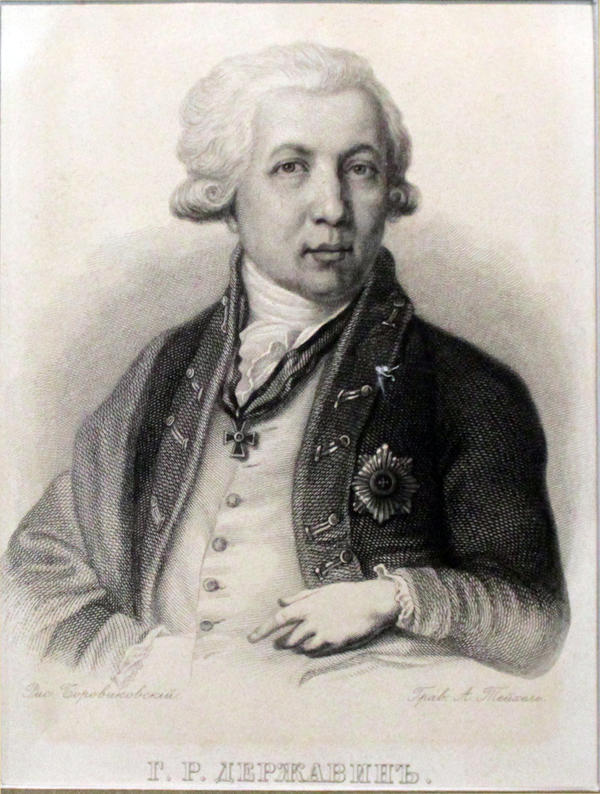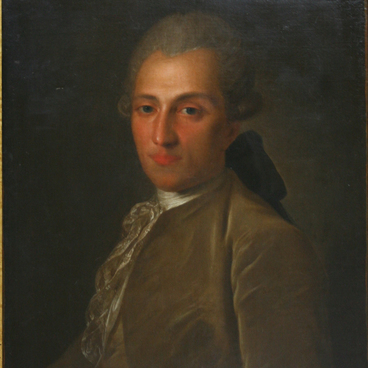The engraved portrait of Gavriil Derzhavin was made by A. Teichel from a miniature portrait painted by Vladimir Borovikovsky. The exact date of its creation is unknown. The original painting was kept by Maria Rostovskaya, a writer and publisher, Derzhavin’s goddaughter.
Teichel created the portrait on a steel plate that came to be used instead of copper plates in the late 18th — early 19th century. Steel plates were not easy to wear down; they allowed an unlimited number of impressions to be made while using them. It was impossible, though, to make deep cut lines on such plates; an engraver could only scrape the metal to create an image, which was much more difficult both technically and physically. As the shallow scratches gave a gray tone, the image was deprived of its deep shadows. Later, the engravers stopped using plates of pure steel and switched to applying a thin layer of steel on copper plates. They did it to preserve the softness of the plate and to protect the pattern from print wear.
Teichel created the portrait on a steel plate that came to be used instead of copper plates in the late 18th — early 19th century. Steel plates were not easy to wear down; they allowed an unlimited number of impressions to be made while using them. It was impossible, though, to make deep cut lines on such plates; an engraver could only scrape the metal to create an image, which was much more difficult both technically and physically. As the shallow scratches gave a gray tone, the image was deprived of its deep shadows. Later, the engravers stopped using plates of pure steel and switched to applying a thin layer of steel on copper plates. They did it to preserve the softness of the plate and to protect the pattern from print wear.
Gavriil Derzhavin was a Russian poet and statesman of the Enlightenment era. Between 1786 and 1788, by order of Catherine II, Derzhavin governed the Tambov province. During that period, he actively began to build the town of Tambov following an architectural plan: an orphanage, a hospital and an alms-house, a charity shelter for people who could not work due to their age and health. Derzhavin also founded the main four-year specialized public school in Tambov and some small two-year schools in local towns. Gavriil Derzhavin was a Russian poet and statesman of the Enlightenment era. Between 1786 and 1788, by order of Catherine II, Derzhavin governed the Tambov province. During that period, he actively began to build the town of Tambov following an architectural plan: an orphanage, a hospital and an alms-house, a charity shelter for people who could not work due to their age and health. Derzhavin also founded the main four-year specialized public school in Tambov and some small two-year schools in local towns.
In 1788, he established a printing house that issued the first provincial newspaper in Russia, the Gubernskiye Vedomosty (News of the Province). Derzhavin tried to arrange merchant shipping on the Tsna River; he drew up a draft plan for a gateway device worth 20 thousand rubles, but got no money from the Treasury. In 1790, when he was assigned the post of cabinet secretary to Catherine II, Derzhavin returned to St. Petersburg.
Various graphic portraits of Gavriil Derzhavin were collected by Leonid Voeykov, Derzhavin’s grandnephew. In Tambov, he was known for his historical studies and a collection of Russian printed engravings of the 18th — 19th centuries that included portraits of Russian and foreign public figures. After Leonid’s death in 1886, Sofia Voeykova, his widow, handed the collection over to the art department of the Naryshkin Special Library. From there, the portraits were transferred to the Tambov Regional Ethnography Museum.



